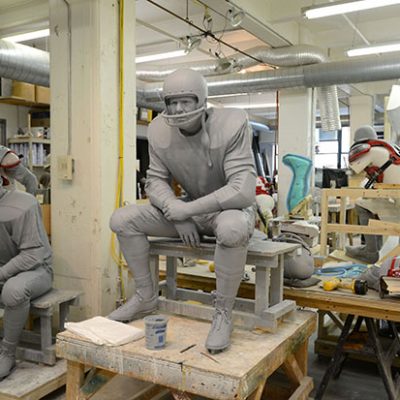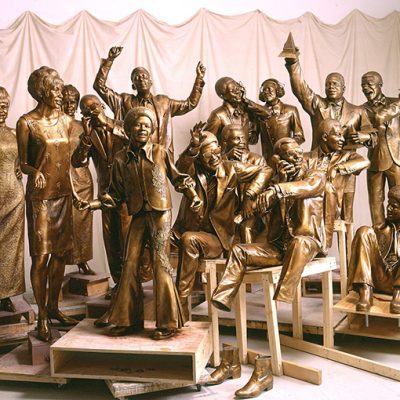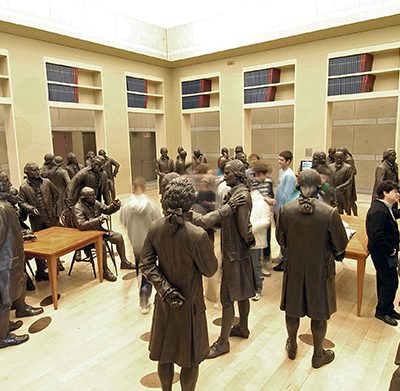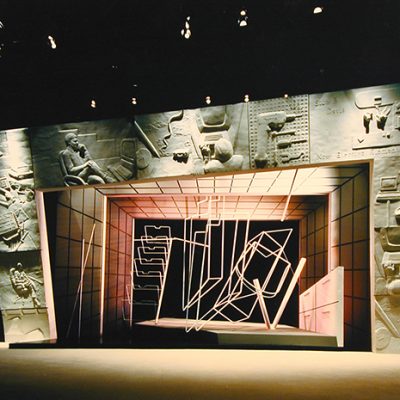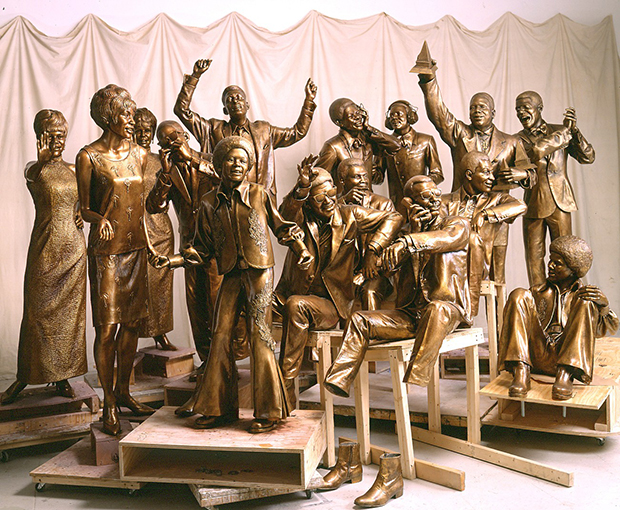
How a design studio in DUMBO has managed to carve an international niche creating historical and corporate figurative sculpture
By Jessica Jones-Gorman
Ivan Schwartz spent the early part of his career toiling as an abstract artist—hawking work at random galleries in Manhattan, while at the same time trying to build a resume for himself at museums in both New York City proper and Minnesota. But 38 years ago, when landmark events reinvigorated a zest for American culture, the classically trained sculptor/painter and his brother, Elliot, an industrial designer and photographer, found their artistic niche.
“The American Bicentennial had just taken place and it was a significant moment in this country’s history,” noted Schwartz, vice president of StudioEIS, a sculptural and design studio in DUMBO that specializes in “visual storytelling”— which for Schwartz means the production of figurative sculpture in bronze, stone, and resin for exhibitions at cultural institutions, museums and corporations.
“We started to see a new movement of museum building in the United States—historical anthropology museums, sports history centers, and then America was taking a look back in every aspect of historical and cultural life,” Schwartz continued. “This confluence of American history was a perfect fit for people like me who could provide a way in which to picture ourselves three dimensionally.”
So, the brothers combined skills and started crafting. Their earliest commissioned project was an exhibit for a cultural history museum in Minnesota.
“An abundance of iron ore brought Germans, Norwegians, and other Scandinavians to an iron range in a fairly remote part of Minnesota in the late 1800s,” Schwartz explained. “This natural resource had to be taken out of the ground, and this particular group of workers was the only one that had the skills to do it. The museum was paying tribute to that part of the state’s history, so the people we depicted in our sculptures were these iron miners.”
That well-received first project paved the way to a second and third of varied but similar natures. An installation for the Japanese Space and Science Exposition soon followed.
“There we were in Tokyo, meeting people who worked for these great institutions,” Schwartz said. “A year later we were doing work for the Smithsonian Museum.”
In 1981, after being commissioned by a museum in Galveston, Texas to craft another major work, StudioEIS had found its place on the world’s museum exhibition map.
“We had occupied the same studio space for close to a year, had developed a smallish staff to do some of the sculpting, and I can remember thinking, ‘Hey we’re in business!’” Schwartz said. “We created some marketing tools and did a little PR in hopes of attracting more projects. Gradually our name became known in the world of museum development.”
At a burgeoning time for the museum industry itself, StudioEIS (shorthand for Elliot Ivan Schwartz), started providing quality bronze figure work for diverse institutions.
“Instead of using mannequins in museums, they came to StudioEIS to create figures that only we could create,” Schwartz said. “Jump 33 years down the track and we’ve done more bronze figures than any studio in the history of the United States. In our little niche world, we’ve produced hundreds of projects for important cultural and historical organizations throughout the world, and what a wonderful experience it has been.”
A boom of projects followed in the ’80s and ’90s, including pieces for fine arts museums, national monuments, and sports centers across the country. More modern work includes pieces for corporate leaders like Coca-Cola, Nike, Martha Stewart, Motown, Sony Music, TV Land, Tiffany, and Royal Caribbean International, as well as a number of restaurants and hotels. StudioEIS has been profiled by The New York Times and was even featured in a History Channel documentary, but Schwartz offered that his company’s watershed moment was a 2001 hire by the National Constitution Center in Philadelphia in which StudioEIS created
42 bronze figures of the signers of the Constitution.
“We must maintain a broad visual vocabulary in order to accept any challenges,” Schwartz said of his consistent 12- to 15-person staff that sometimes doubles to accommodate a specific workload. “We can’t just look at life through one lens; we need to be able to sculpt an abstract piece for the Bellagio one day, and an historical exhibition the next.”
The studio, which began its life in a small loft in Manhattan’s West Village, has been operating out of its current headquarters on Washington Street for the past 28 years.
“There was cheap, vacant space available in what later became DUMBO, and a lot of artisanal manufacturers and designers were moving home base to Brooklyn,” Schwartz said. “There were some dress manufacturers here, people who made boxes for jewelry, and another business that produced gaskets for the automotive industry. I think the rent was something like $3 per square foot. But the history of this city is forever evolving. Rents have climbed, and those small shops are now all gone and the world here has changed. We’re surrounded by the headquarters of Etsy now and a lot of information technology businesses.”
StudioEIS is actually set to leave DUMBO at the beginning of August to move to a newer space in Industry City.
“We’re excited about it,” Schwartz said. “DUMBO had become such a major tourist attraction and undergone a total transformation throughout the years. It will be interesting to be in a place that is a bit more subdued but still up and coming.”
The studio’s surroundings are not the only thing that has changed throughout the years. Over the past three decades, the business itself has morphed and modernized.
“This industry is based around the work of very gifted artists and artisan sculptors who can actually still outpace a computer,”
Schwartz said. “But we now have digital technology that allows us to scan objects with lasers and take thousands of measurements, transforming anything into a three-dimensional output. Keen, artistic skills are still the basis of the business, but these days they are not always enough. Digital technology must play a peripheral but significant role in what we do.”
Future projects for StudioEIS include bronzes of Mark Twain and Edsel Ford, as well as a sculpture of Richard Smith, who founded Smithtown on Long Island.
“No matter how many large scale projects we tackle, it still amazes me that we’ve carved a place for ourselves in this niche world of design,” Schwartz concluded. “We’ve been able to travel the world and create lasting artwork that many generations will witness and enjoy. For me, that is the most fulfilling part.”
StudioEIS
55 Washington St., / 718.797.4561 / studioeis.com



